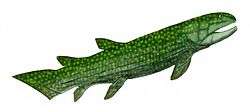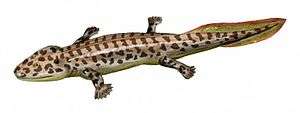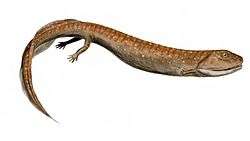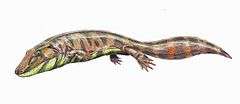Osteolepiformes
Osteolepiformes, also known as megalichthyiformes,[1] are a group of prehistoric lobe-finned fishes which first appeared during the Devonian period. The order contains two families: Megalichthyidae and Osteolepidae. The Order is generally considered to be paraphyletic because the characters that define it are mainly attributes of stem tetrapodomorphs.[2]
| Osteolepiformes | |
|---|---|
 | |
| Osteolepis | |
| Scientific classification | |
| Kingdom: | Animalia |
| Phylum: | Chordata |
| Clade: | Tetrapodomorpha |
| Order: | †Osteolepiformes |
| Families | |
Below is a cladogram showing the Osteolepiformes modified from Swartz 2012.[1]
| Osteolepiformes |
| ||||||||||||||||||||||||
References
- Swartz, B. (2012). "A marine stem-tetrapod from the Devonian of Western North America". PLoS ONE. 7 (3): e33683. Bibcode:2012PLoSO...733683S. doi:10.1371/journal.pone.0033683. PMC 3308997. PMID 22448265.
- Ahlberg, P. E.; Johanson, Z. (1998). "Osteolepiforms and the ancestry of tetrapods" (PDF). Nature. 395 (6704): 792–794. Bibcode:1998Natur.395..792A. doi:10.1038/27421. Archived from the original (PDF) on 2014-11-24. Retrieved 2010-01-30.
This article is issued from Wikipedia. The text is licensed under Creative Commons - Attribution - Sharealike. Additional terms may apply for the media files.





